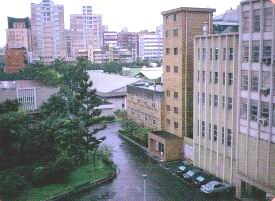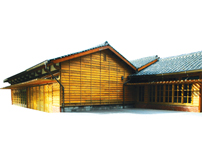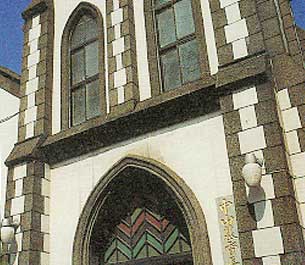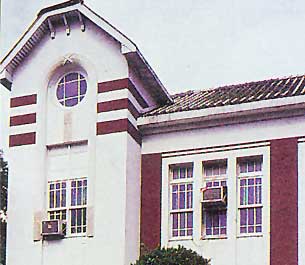 Jianguo Brewery
Jianguo Brewery Originally established under the Japanese colonial government, the Takasago Beer Company, the Jianguo Brewery's forerunner, was the first brewery in Taiwan and enjoyed prestige on par with the Sapporo Brewery of Hokkaido, Japan. Expanded in the1960s, the Jianguo Brewery achieved production of over 144 million bottles, with its quality lager even winning international awards including the Monde Selection award of Belgium.
The original complex featured a mixture of structures made of red bricks, stones and steel-reinforced concrete. Later additions were primarily structures with brick walls and steel trusses, reflecting the evolution of construction technology. Although now decommissioned, much of the facility's equipment remains on-site as historical evidence of the development of Taiwan's beer brewing industry.
 Tsai Jui-Yueh Dance Research Institute
Tsai Jui-Yueh Dance Research Institute
The Tsai Jui-Yueh Dance Research Institute building was a dormitory for government employees during the Japanese era (1895-1945). The houses in this predominantly Japanese neighborhood were arranged in orderly rows and were of uniform size. Following World War II, many prominent officials of the Republic of China such as Huang Chi-ruey and Huang Chao-ching took up residence in this district.
After studying dance in Japan, Ms. Tsai Jui-Yueh embarked on a career in dance instruction, founding the Chung-hua Dance Research Institute in 1953. Internationally recognized as a choreographer and performer, she composed over 200 works and was versatile in ballet, modern dance and traditional folk dance. She became highly regarded as an educator and a pioneer promoter of modern dance in Taiwan.
Damaged by fire in October 1999, the building housing Tsai's dance studio has been restored to its original appearance.
 Zhongshan Presbyterian Church
Zhongshan Presbyterian Church
The Taisho Street Anglican Church during the Japanese colonial period (1895-1945) became a Presbyterian church following World War II.
The Zhongshan Presbyterian Church's distinctive architectural design is based on a cruciform floor plan running on an east-west axis. Special design features include a three-tiered bell tower, Gothic windows and a buttress on the outer wall. The church’s cruciform plan keeps the Anglican tradition of a pulpit on the left side of the altar and a lectern for scripture recitation by lay readers on the right. The interior includes arched suspension roof trusses, an architectural element rarely seen in Taiwan, achieving a classically reverential atmosphere.
.jpg) Yuanshan Villa (Taipei Story House)
Yuanshan Villa (Taipei Story House)
Built as a garden retreat by Tea Merchant Association founding chairman and wealthy businessman Chen Chaojun, the Yuanshan Villa first served as a reception house and family gathering place. Originally visitors reached the villa from the district of Dadaocheng by boat via the Tamsui (Tamsui) and Keelung rivers. Dr. Sun Yat-sen once visited the villa while in Taiwan.
The building has had a complicated history of ownership. For a time occupied by the Japanese military police, it was also the home of former Legislative Yuan president Huang Kuo-shu after World War II.
Constructed in the English Tudor style, a rarity in Taiwan, the villa is made of brick on the first floor and wood on the second story. The posts and beams, exposed on the exterior wall, are carved in a tree-branch design. A semi-circular balcony with neoclassical columns covers the entranceway, and the steeply sloping roof has a central spired cupola. The intriguing rear staircase is built like a small tower, with curving eaves and arched Art Nouveau windows. Courtyards were once situated to both the building's front and rear. Old Taipei City Health Department
Old Taipei City Health Department
Originally a technical arts training center during the Japanese colonial period (1895-1945), this building was dedicated to technical training and vocational counseling, thereby addressing the problem of unemployment during the Great Depression of the 1930s. It stands as a significant historical landmark of the development of social welfare services in Taipei City. Following World War II, it was transformed into a laboratory for the Taipei City Health Department.
The building features a symmetrical European-style design, with towers rising above both wings. A sloped roof facilitating rain drainage has now replaced the original semi-circular roof, which featured circular cavity windows and horizontal ribbon embellishments.

![Taiwan.gov.tw [ open a new window]](/images/egov.png)
